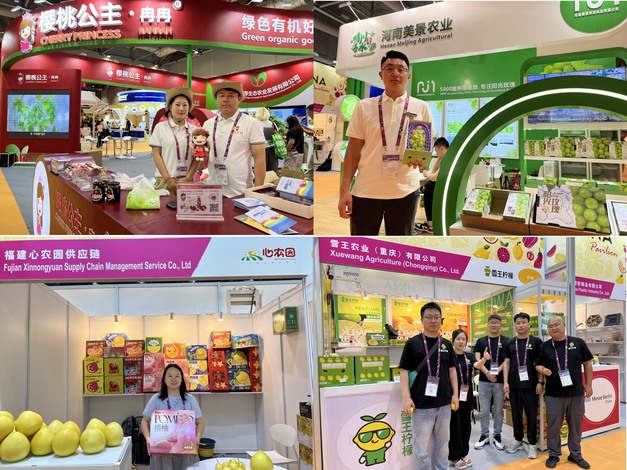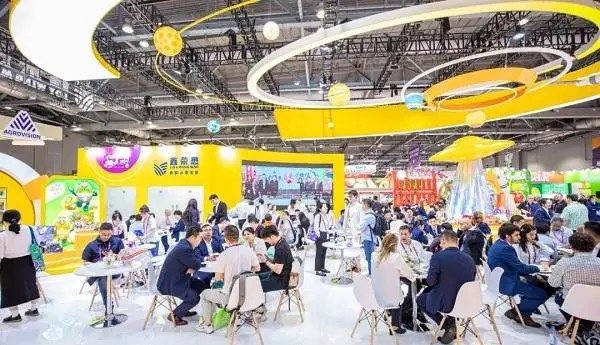Asia Fruit Logistica 2024, held in Hong Kong from September 4 to 6, attracted 280 Chinese exhibitors, marking a 12% increase from last year. Exhibiting areas from various Chinese regions, including Sichuan, Hebei, Shaanxi, and Shanxi, showcased a wide range of products.
Many exhibitors provided samples for tasting, while others, whose products were out of season, displayed beautifully packaged offerings. Despite some weather-related delays on the third day, most Chinese exhibitors expressed satisfaction, noting higher attendance and a greater number of professional exhibitors compared to the previous year.
Several equipment companies, such as Reemoon, displayed large-scale equipment with live demonstrations, drawing significant attention. Booths of well-known retailers like Dole, Joy Wing Mau, and Pagoda were packed with visitors, often lacking enough seating due to the high volume of attendees. Many companies, including Joy Wing Mau, hosted dinner events after the first or second day to thank traders and partners.
Notably, alongside importers, exporters, and retailers, a growing number of exhibitors specializing in single products made a strong impression at this year's event. These companies showcased their innovative progress in fruit and vegetable cultivation, with new products like Yunnan avocados, Liaoning cherries, and Hainan yellow dragon fruit capturing widespread attention.
Many of these growers had begun experimenting with these crops only a few years ago, with this year marking their first large-scale harvests. The exhibition aimed to raise awareness among Chinese consumers that fruits once exclusively imported are now being successfully cultivated in China.
Cherry Princess, a company with cherry plantations across Northeast China, highlighted the growing potential of domestic cherries. A company representative shared, "The taste and quality of domestic cherries are just as good as imported ones. The main advantage of imported cherries is their different seasonal availability. Although domestic cherries are currently priced similarly to or even higher than imported ones, we plan to scale up production to allow more consumers to experience our product."
Yunnan Bafang Agriculture also gained significant attention with its China-grown avocados. The company, which began planting a few years ago, is now producing fruit at scale and used this event to showcase its avocados, attracting many inquiries.

In addition to showcasing new varieties, the exhibition featured several large growers participating for the first time.
Sichuan Snow King Lemons, a first-time exhibitor, focuses solely on lemons. Established in 2019, the company operates multiple automated processing plants and aimed to explore export opportunities at the event. "Our primary goal was to introduce our new logo and connect with professional traders. Despite having just a standard booth, we received a lot of interest," said Ma, the company's sales manager. "We hope to promote standardization within the lemon industry and increase global awareness of Chinese lemons."
Henan Meijing Agricultural, another first-time exhibitor, displayed various Shine Muscat grape products, attracting many visitors. The company operates a 5,000-mu (334-hectare) vineyard and has now reached mass production. "Although the Shine Muscat market is becoming saturated, companies that specialize in a single variety will have a competitive edge," explained the company's sales representative. "We are very pleased with our first exhibition and plan to expand our booth next year."
Fujian Xinnongyuan Supply Chain, also debuting at the expo, showcased honey pomelo in various sizes and packaging options. Their representative noted, "The fruit industry has not fully recovered to pre-pandemic levels, but demand remains strong. As long as we maintain high-quality products, we believe there will always be traders interested."

Despite the weather affecting the final day, most Chinese exhibitors were satisfied with the exhibition's overall success. Attendance and engagement from professional traders on the first two days exceeded last year's levels, with some exhibitors securing potential orders from new clients. Although the third day's opening was delayed due to weather conditions, many exhibitors made early preparations and took the opportunity to network and visit other booths on the second day.
In conclusion, this year's Asia Fruit Logistica not only saw an increase in Chinese exhibitors but also welcomed new companies and innovative products, injecting fresh energy into the fruit industry.
View the Photo Report of companies from around the world.
